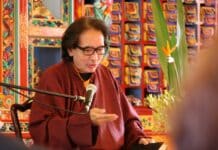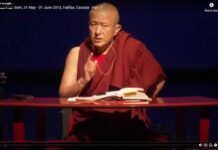
The exemplary story of the birth of a guru is that of Padmasambhava. He is born on the calyx of a huge lotus flower in the middle of a lake. The lotus represents the vagina and the womb, so it is understandable if a child is born from a lotus. But another aspect of the symbolism is important here. The lotus roots in the mud, yet itself it is entirely pure. Thus it is a symbol of purity rising out of defilement, or of purity amid defilement. The analogy here is that of pure perception. Perception merely reflects what is. Whether what it perceives is gorgeous or ghastly, perception itself remains accurate and vivid and clear. In its essence it is unobstructed, precise, potent, unlimited. Above all, it is impartial, completely without bias. It may not say, I will perceive this but not that, for before the moment of choice, it must already have perceived it. Thus perception itself stands beyond manipulation and prejudice.
So the birth of the guru as a babe in the lotus expresses the miracle of pure perception amid the welter of phenomena. That miracle is inseparable from the awakened mind of the guru. The guru is that miracle, whether he wants to be or not. It is choiceless.
The Vidyadhara Chögyam Trungpa Rinpoche was such a guru. He was the child of pure perception. For this reason, he cannot be described as one describes an ordinary personality. To say he was many-faceted does not go far enough. One should say he was “any-faceted,” for the miracle of unobstructed perception that was alive in him in all situations choicelessly mirrored whoever he was relating to. He presented an interface of communication that reflected that person or those persons. It was automatic, it was natural and spontaneous, it was not encumbered by a program, it did not get hung up on preferences and aversions. It saw deep and reflected clearly.
If you came into his presence, you were perceived by him in this way, and this gave you a deep sense of your own reality, perhaps deeper than you had ever experienced. This had a double edge, because at the same time Rinpoche saw your basic intelligence and warmth, he also saw the tissue of neurosis and falsity that habitually obscured it — what he called your “trip.” Because of this pure way of seeing that was an inalienable part of him, just his being there with you effortlessly kindled a direct feeling of what was authentic in you, and at the same time a sense of how you were continually slipping away from that authenticity. In this way, being with him blew both hot and cold. It could be exhilarating and inspiring; it could be mortifying and terribly disappointing. Sometimes, rarely, it could be both at the same time, which was tantamount to you yourself waking up and seeing like him. On the whole, whether it made you feel good or bad, being with him was uplifting. Why? Because in communicating with him, happy or sad, you felt the force and naturalness of your basic nature and the flimsiness of your trip. In this sense, if you lost, you couldn’t lose. The buddha-nature percentages were on your side.
But if arrogance or attachment fortified your trip and made you stubborn, causing you to willfully thwart the effects flowing to you from communication with Rinpoche, then you caught the black, dead side of his mirror. You were shut out, thrown back — into a mini-hell of self-disgust.
So this mirroring was fundamental to interaction with the Vidyadhara. It came about just from his perceiving you. It didn’t matter what he was doing or what was going on. It potentiated automatically, even without anything being said or done. It might work even if Rinpoche was out cold, asleep, unconscious. Even then, the force of it seemed to continue. His death itself does not seem to have canceled it. The mere thought of him still seems to occasion flashes of pure objective seeing. His pure perception was and is a self-existing agent, with no particular allegiances, no particular kindness, no particular malice. Its responses spontaneously conformed to what you presented him with. His behavior engaged yours almost as though he had no content of his own. This could be extremely frightening. There was something CCL about it. It was beyond us.
If it hadn’t been for the immense unselfish love and caring and the irrepressible affection and playfulness that accompanied it, perhaps it would all have been too frightening. It is said that wisdom and compassion are inseparable. That would account for the phenomenon.
It is a fact that in his any-facetedness, Rinpoche had absolutely no difficulty in keeping many different interfaces going at once. In a room with ten people, he was naturally, spontaneously, and yet with complete consciousness, each of their Rinpoches for each of them. A traditional saying goes, “He who goes into the forest to cut firewood comes out having cut his own image (with a bundle that resembles himself).” In this case, each student went into the relationship with the Vidyadhara and came out with something different. To an amazing extent, individuals were aware of certain activities and qualities of his but fairly oblivious of others that were important to other people. In their relationship with the Vidyadhara, everybody followed his or her particular thread of continuity. Thus the Vidyadhara presents the problem of history in a particularly acute form. It has been said by historiographers that there is no definite, solid history as such, no “what really happened.” Instead we have a changeable body of perceived facts reshaped by each new view. In the same way but even more so, the Vidyadhara could never be pinned down! He seemed to enjoy this. A student who knew Rinpoche in the early days at Samye Ling in Scotland recounts coming into his room unannounced one day and finding him naked in front of a mirror. He had a big smirk on his face and was doing a kind of little dance while chanting in singsong, “I’m a slippery fish. No one can catch me!”
Meeting the Vidyadhara gave a shape and direction to our lives. As already described, he recognized on the spot who we were and reflected it back to us. Sometimes the effect of this was harsh. At the same time, Rinpoche’s kindness was unflagging; he joined in simple empathy for our suffering, knowing its depths in an instant. He instructed and admonished us. He developed scenarios to expose our ego trips. He sought our ultimate benefit in every way. He loved us. He embraced us physically like a father, like a mother, like a lover, even like a child. He cared for us endlessly, boundlessly, with incredible insight and humor. He was our family, teacher, and heritage rolled into one.
Hearing Rinpoche teach or just talk, seeing him move or smile watching him react to questions, for example — provided glimpses of awakening, bursts of vivid experience, flashes of magic. The astonishing adaptability and fertility of his mind gave a sense of a boundless resource of spirit or mind that could cheat the doom of the expected. There was the sheer delight of the shining slippery fish of wakefulness that could not be netted by conventional thinking — or by conceptual mind on any level! There was the humor and celebration of non-dualistic mind, of mind that does not get caught in its own reflections and projections and become cowed by them. We beheld this delightful virtuoso display with wonder. We were astounded. Some people were offended. Many of us were utterly thrilled. We loved that delight, that playfulness, the infinite ability of the Vidyadhara to run between the raindrops.
Since we wanted to go, he took all of us along on a journey, an incredible journey, with him. He worked with tremendous exertion for over twenty years in the West. Through teaching, artistic activity of many kinds, personal relationships, building organizations and institutions, he created a series of situations of increasing intensity and effectiveness. For his students, participating in these ever unfolding situations entailed constant surrender and growth. It also meant traveling through life with Rinpoche, with the Vidyadhara, as a constant conscious and subconscious companion.
The element of companionship was a big part of the thing. Often the Vidyadhara could be hard — stern and disapproving. He could ignore you; he could emit fearsome black air in your direction; he could exile you from his presence for days, weeks, or years. But what is profoundly touching in retrospect is that, ultimately, his companionship never failed. Somehow, miraculously, when you needed his help in a deep and personal way, situations shifted, doors opened, walls disappeared, and there he was. You were with him and he touched you in a moment of pure love and understanding. Even when one was cut off and laboring under his disapproval, that sense of fundamental support was always there. Again and again, we saw that what he did was done to enable us to take a further step along the path. And we saw that he was willing to die rather than betray his bond with us. Which is, of course what he did.
He often said that his relationship with us was a love affair. But this can never be understood properly if it is not clear that this love affair took place against a backdrop of tremendous challenge. Relationship was not offered by the Vidyadhara in a context of complacency and comfort. Rather he offered us his hand to make a harrowing personal journey beyond ego. It was a quality of the depth of his compassion that our challenge became his, our risk his; he shared with us our pain, failure, loss, or happiness, our moment of breakthrough. For years and years, our daily existence had him as its constant reference point; our path through life hung and hangs on his strength and his example.










